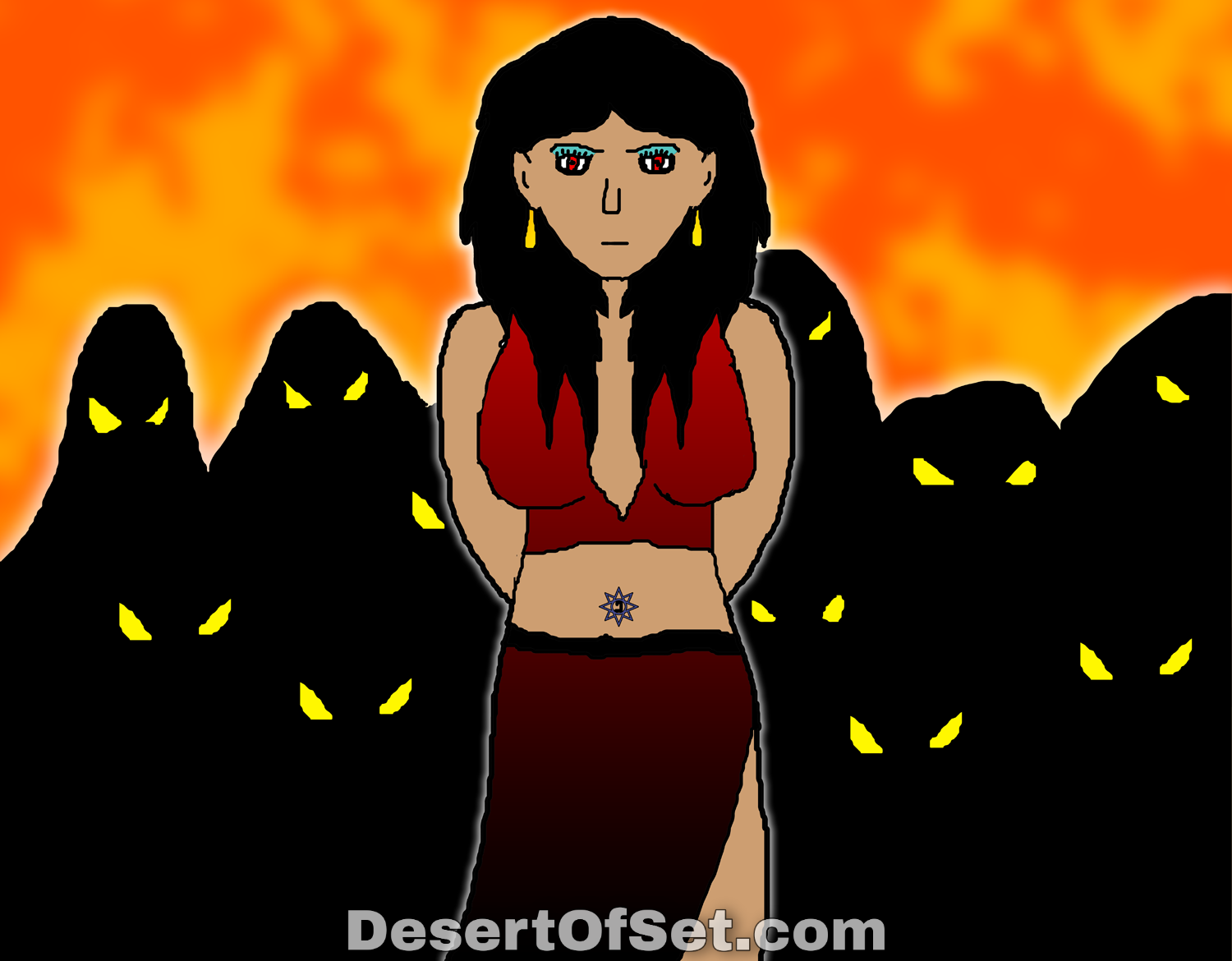She rebelled to help humanity before Prometheus. She died and rose from the grave before Jesus. And She invented the “zombie apocalypse” before George Romero.

Almost every culture has viewed Venus—the “Lucifer” or Morningstar—as an aggressive, contrary force. This is because it is usually the first star seen at sunset, and the last star seen at dawn. Based on this phenomenon, people imagined that Venus is a “rebel” who defies the Sun, refusing to disappear as her superior rises, then rushing to ascend as the Sun sets. Even before medieval Christians incorporated Lucifer into their devil myth, most theological beings associated with Venus were perceived as unruly, cosmic shit-disturbers.
Ishtar, the Akkadian Goddess of Venus, is no exception. She stole the sacred mes, the powers of civilization, from Her uncle Ea and gave them to the people of Uruk. She insisted on visiting Her deadly sister Ereshkigal, the Queen of the Underworld, and conquered death in the process (with some help from Ea). When She learned Her husband Tammuz had not grieved for Her at all while She was dead, She killed and kicked His ass straight down into hell. When the “hero” Gilgamesh refused to marry Her, She sent the apocalyptic Bull of Heaven after him. And when Her father Anu refused to give Her the Bull at first, She threatened to raise all the dead across the earth and send them to feast on the living. She is also said to have an insatiable sex drive, exhausting all of Her various lovers to death.
If you think that sounds bad, Gilgamesh was a king who tyrannized his people, breaking into their homes and raping all the women. He only stopped when the Gods created Enkidu to challenge him, giving him something else to do with his time. Gilgamesh then became so obsessed with finding the secret to immortality that he abandoned his people and left them to fend for themselves. (What an asshole!) So it’s always seemed weird to me that he is portrayed as the “hero” in this story (despite being a tyrant and a rapist), while Ishtar is framed as the “villain” (even though She is divine and transcends all human understanding). The greatest threat Ishtar poses for this megalomaniac is not to his life, but to his ego.
(If Ishtar appeared and said She wanted to marry me, I’d say, “Okay.” Better to be mauled ecstatically by Ishtar’s lovely, blood-splattered mouth than to die by the hand of any mortal man!)


Ishtar appears in Babylonian art as a badass Amazon standing on a Gods-damn lion, getting ready to beat the shit out of some motherfuckers. Assyrian kings prayed for Her to join them on the battlefield like a Valkyrie and slaughter their foes like cattle. (And if their records are to be believed, She answered their prayers…brutally.) As a warrior Goddess, Ishtar was very popular with the Hyksos, who called Her Astarte and paired Her with their chief deity, Ba’al Hadad. When the Hyksos ruled Egypt during the Second Intermediate Period, they brought Ishtar’s worship into the Land of the Pharaohs. And since Ba’al Hadad was identified with Set by the Egyptians, they came to view Ishtar/Astarte as one of Set’s romantic interests as well.
There is a fragmentary Egyptian text from Edfu in which Yamm, a sea monster, demands the hand of Ishtar in marriage. For a moment, it seems the beast will claim its bride; but Set intercedes, and while the rest of the story is uncertain, there is a similar Ugaritic tale in which Ba’al Hadad rescues Astarte from Yamm. Since Hadad’s name is substituted for Set’s in the Edfu texts, the Egyptian version most likely ends with Set destroying Yamm and marrying Ishtar. Considering Their unruliness and Their shared frustrations with dying-and-rising fertility Gods (like Osiris and Tammuz), don’t you think Set and Ishtar make a perfect couple?

Ishtar is often vilified for being so “promiscuous.” This is due to a complete misunderstanding of hierogamy or hieros gamos, the concept of “sacred marriage.” It is a religious rite in which people have sexual intercourse, with at least one of the participants being “possessed” by a deity. Such procedures served a twofold purpose in the ancient world. The practical purpose was to channel the fertility of a God and/or Goddess into the crops, livestock, and people of a community. The spiritual purpose was to reach a higher level of consciousness. Under the right circumstances (all of which require CONSENT), a really good orgasm can totally “blow your mind” and make you feel like you’re in tune with the rest of the cosmos. It makes total sense why people would consider that ecstatic moment of self-surrender to be supremely magical. From this standpoint, sex can be much more than just some “dirty” animal act; it can be a divine religious experience that is both self-fulfilling and incredibly humbling.
The clergy in ancient religions that practiced hierogamy are often described as “cult prostitutes” by biblical scholars. This is especially true when it comes to the qadishtu or holy women of Ishtar. Sex did in fact play a part in the beliefs of the qadishtu, and they were ostensibly paid by the laity for their clerical services. But the way I see it, there probably wasn’t always a direct relation between these two things.
First of all, it is unclear whether Ishtar’s holy women actually engaged in hierogamy with everyone who entered their temples, or if just one priestess performed the rite with a king during the annual Akitu spring festival. To be honest, I have my doubts that even the latter case was always true. Many contemporary examples of hierogamy (such as the Great Rite in Wicca) are often performed symbolically (e.g., sticking an athame in a chalice, rather than actually copulating). It is entirely possible that hierogamy wasn’t always practiced quite so literally in pre-Christian times, either.
Secondly, it is wrong to assume that every service the qadishtu provided for their society was sexual in nature. In fact, it is very likely that most of what they did had nothing to do with sex at all. The available evidence would seem to suggest they were more like nuns than nymphs, caring for the sick and the orphaned, keeping chaste, and living their day-to-day lives in quiet, contemplative prayer. So the fact that Herodotus and the biblical patriarchs defined the qadishtu in terms of sex says infinitely more about them and their dirty little minds than it does about Ishtar’s holy women.

The Mušḫuššu dragon from the Ishtar Gate
Yet another attack on Ishtar is the false claim that She is the alleged “Pagan origin” of Easter. This story goes back to Alexander Hislop, who published a pamphlet called The Two Babylons in 1853. Hislop claimed that Ishtar was originally a mortal Babylonian queen named Semiramis, who single-handedly invented all of polytheism. She then became worshiped as Ishtar—which many Christians claim is pronounced “Easter” for some reason—and created the holiday we now know by that name for herself.
Hislop was partially correct; Easter does in fact have polytheist origins. But its name is actually derived from Eostre, a Teutonic fertility Goddess who bears no historical relation to Ishtar whatsoever. The imagery of rabbits and eggs is taken from a myth in which Eostre transformed a bird into a rabbit that could lay eggs (the Easter Bunny). These symbols do not appear anywhere in Ishtar’s iconography, which has plenty more to do with bulls, dragons, lions, and owls. Nevertheless, evangelicals continue to repeat Hislop’s bullshit at every turn, criticizing Easter as a so-called “satanic” rite to Ishtar.

The Burney Relief, depicting an unknown female figure who could be Ishtar or Ereshkigal (but who likely isn’t Lilith)
One thing that really sticks in my craw is when people confuse Ishtar with the succubus, Lilith. In the 1970s, many Pagan writers circulated a claim that Lilith originated not as the “first wife of Adam,” but as a “handmaiden” of Ishtar who served the Goddess by bringing men to Her temple for worship. Another claim states that Lilith is really a Goddess in her own right; she was later demonized, or so the story goes, when biblical patriarchy replaced the Goddess religions of old. And some people seem to think Ishtar and Lilith are really just the same person at the end of the day.
There is no evidence to support any of these theories. Even in pre-biblical polytheist cultures, Lilith was a qliphothic entity that ate newborn children and sapped men of their seed at night. She was never worshiped, but was only warded off with apotropaic spells. This was as true when the Epic of Gilgamesh was being written as it was when the Old Testament was being written. I can accept the idea of people believing Lilith is a Goddess today, if that is truly how they feel; but they should admit this is a new belief in the grand scheme of things, and not an ancient one. They should also avoid conflating Ishtar with Lilith, because the two are very different figures indeed. At the very least, the former is my Spirit Mama, and the latter is not.

I first met Ishtar in McClennan County, Texas, during the autumn of 1999. I was about to turn 17, and I had been walking with Set for just over two years. I can’t really explain what drew me to Ishtar so suddenly that cloudy afternoon; the best I can say is that Set “traded” me with Her, and I walked with Her for the following year. They traded me back after that, and I’ve been with Set ever since. I never quite understood why this happened until about a decade later, when I met the woman who became my wife. We met in a Pagan discussion forum, and the only reason we did is because I wanted to meet other people who knew about Set, and she wanted to meet other people who knew about Ishtar. Considering this, we’ve always felt that Set and Ishtar are personally responsible for micromanaging things just so the two of us would meet. And that hiatus I had with Ishtar was the Goddess sizing me up as a potential match for one of Her contemporary qadishtu. (I sure am glad I passed the test!)

